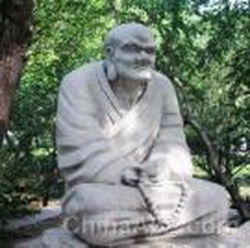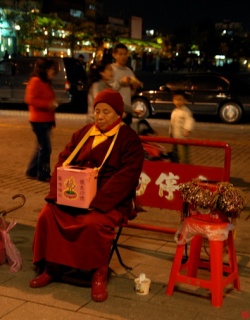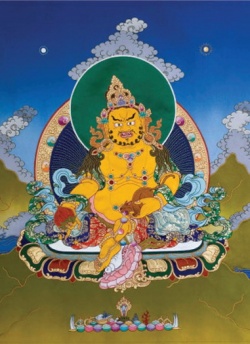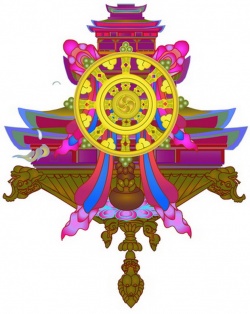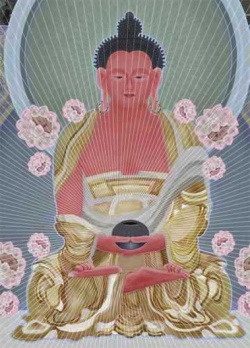Difference between revisions of "Buddhabhadra"
(Created page with "thumb|250px| <poem> '''Buddhabhadra''' [仏陀跋陀羅] (359–429) (Skt; Jpn Buddabaddara) A monk of northern India who was active as a tran...") |
|||
| (9 intermediate revisions by the same user not shown) | |||
| Line 1: | Line 1: | ||
| − | [[File:Buddhabhadra560.jpg|thumb|250px|]] | + | [[File:Buddhabhadra560.jpg|thumb|250px|]]<nomobile>{{DisplayImages|2830|119|1697|1093}}</nomobile> |
<poem> | <poem> | ||
| − | |||
| − | |||
| − | |||
| − | |||
| − | |||
| − | Buddhabhadra and his Chinese disciple Xuangao are known to have advocated the twin principles of samadhi (meditative concentration) and prajna (transcendent wisdom). These were later inherited by the Tiantai school of Buddhism, and its patriarchs Huisi and Zhiyi. Buddhabhadra's views in turn stemmed from those of Buddhasena's Dhyāna school in Kashmir, and their meditation manual was translated by Buddhabhadra at behest of Huiyuan, the founder of the Chinese tradition of Pure Land Buddhism. This Indian meditation manual preserved in Taisho Tripitaka 618, and is typically called the Yogacarabhumi Sutra or the Dharmatrata Dhyana Sutra. This text was later prized by the Zen school in China, and parts of its lineage to the Buddha became entangled in sectarian conflicts between factions of Chinese Buddhism. | + | |
| + | |||
| + | |||
| + | |||
| + | |||
| + | |||
| + | |||
| + | [[Buddhabhadra]] | ||
| + | |||
| + | [[仏陀跋陀羅]] (359–429) (Skt; Jpn [[Buddabaddara]]) | ||
| + | |||
| + | |||
| + | A [[monk]] of {{Wiki|northern India}} who was active as a [[translator]] in [[China]]. | ||
| + | |||
| + | |||
| + | |||
| + | He entered the [[monkhood]] in his youth and received instruction in the teachings on [[meditation]] in {{Wiki|Kashmir}}. | ||
| + | |||
| + | [[Buddhabhadra]] ([[佛馱跋陀羅]], 359–429) means [[enlightenment]] [[worthy]]. Born in {{Wiki|northern India}}, he was a descendent of [[King]] Amṛtodana, who was the youngest of the three uncles of [[Śākyamuni Buddha]] (circa 563–483 BCE). He renounced [[family]] [[life]] at age seventeen and became a [[monk]]. Studying hard, he mastered [[meditation]] and the [[Vinaya]]. | ||
| + | |||
| + | |||
| + | In 408, the tenth year of the Hongshi (弘始) years of the Later Qin {{Wiki|Kingdom}} ([[後秦]], 384–417), he went to its capital, [[Chang-an]]. The illustrious [[translator]] [[Kumārajīva]] ([[鳩摩羅什]], 344–413) had arrived there in 401. However, [[Buddhabhadra]] did not like [[Kumārajīva’s]] students. Together with his [[own]] forty-some students, he went to the Lu Mountain and stayed with [[Master]] [[Huiyuan]] ([[慧遠]], 334–416), the [[first patriarch]] of the [[Pure Land School]] of [[China]]. | ||
| + | |||
| + | |||
| + | In 415, the eleventh year of the Yixi (義熙) years of the Eastern [[wikipedia:Jin Dynasty (265-420)|Jin Dynasty]] ([[Wikipedia:Jin Dynasty (265–420|東晉]], 317–420), [[Buddhabhadra]] went to its capital, Jiankong ([[建康]]), present-day [[Nanjing]], {{Wiki|Jiangsu Province}}. He stayed at the Daochang [[Temple]] (道場寺) and began his translation work. | ||
| + | |||
| + | Altogether, he translated from [[Sanskrit]] into {{Wiki|Chinese}} thirteen texts in 125 fascicles. | ||
| + | |||
| + | For example, text 1425 (T22n1425) in 40 fascicles is the {{Wiki|Chinese}} version of the [[Mahāsaṅghika Vinaya]], translated jointly by [[Faxian]] ([[法顯]], circa 337–422) and [[Buddhabhadra]] (Rulu 2012c, 7); | ||
| + | |||
| + | text 376 (T12n0376) is the 6-fascicle {{Wiki|Chinese}} version of the [[Mahāparinirvāṇa Sūtra]], also translated by them (Rulu 2012c, 265). | ||
| + | |||
| + | Text 278 (T09n0278) is the 60-fascicle {{Wiki|Chinese}} version of the [[Mahāvaipulya Sūtra of Buddha Adornment]] (Buddhāvataṁsaka-mahāvaipulya-sūtra), and text 666 (T16n0666) in one fascicle is a {{Wiki|Chinese}} version of the [[Mahāvaipulya Sūtra]] of the [[Tathāgata Store]]. [[Buddhabhadra]] translated texts 278 and 666 alone. | ||
| + | |||
| + | |||
| + | In 429, the sixth year of the [[Yuanjia]] ([[元嘉]]) years of the [[Liu Song Dynasty]] ([[劉宋]], 420–79), [[Buddhabhadra]] [[died]], at age seventy-one. [[People]] called him the [[Indian]] [[Meditation Master]]. He is one of the eighteen [[exalted]] ones of the Lu Mountain. | ||
| + | |||
| + | |||
| + | In 408 (406 according to another account) he went to [[Ch'ang-an]] in [[China]] and propagated the teachings. He assisted [[Kumarajiva]] in the translation of [[Buddhist scriptures]], but later he went [[south]], where he was welcomed by [[Hui-yüan]] at [[Mount Lu]] and lectured on the [[doctrine]] of [[meditation]] at [[Hui-yüan's]] request. | ||
| + | |||
| + | Later he lived at [[Tao-ch'ang-ssu]] [[temple]] in [[Chien-k'ang]] and there translated a number of [[Buddhist scriptures]] into {{Wiki|Chinese}}. | ||
| + | |||
| + | Together with [[Fa-hsien]], he translated The [[Great Canon of Monastic Rules]] and the six-volume [[Mahaparinirvana Sutra]]. He also translated the sixty-volume version of the [[Flower Garland Sutra]]. | ||
| + | |||
| + | In total, he is said to have translated 13 works in 125 volumes (some sources say 15 works in 117 volumes), contributing greatly to the [[development]] of [[Chinese Buddhism]]. | ||
| + | |||
| + | |||
| + | [[Buddhabhadra]] (simplified {{Wiki|Chinese}}: [[佛陀跋陀罗]]; {{Wiki|traditional Chinese}}: [[佛陀跋陀羅]]; pinyin: [[Fótuóbátuóluó]]) (359-429 CE) was an [[Indian]] [[Buddhist monk]], with the title of [[śramaṇa]]. | ||
| + | |||
| + | He is most known for his prolific translation efforts of [[Buddhist texts]] from [[Sanskrit]] into {{Wiki|Chinese}}, and was responsible for the first {{Wiki|Chinese}} translation of the [[Avataṃsaka Sūtra]] ([[Flower Ornament Scripture]]) in the 5th century CE. | ||
| + | |||
| + | |||
| + | [[Buddhabhadra]] and his {{Wiki|Chinese}} [[disciple]] [[Xuangao]] are known to have advocated the twin {{Wiki|principles}} of [[samadhi]] ([[meditative]] [[concentration]]) and [[prajna]] ([[transcendent wisdom]]). | ||
| + | |||
| + | These were later inherited by the [[Tiantai]] school of [[Buddhism]], and its [[patriarchs]] [[Huisi]] and [[Zhiyi]]. | ||
| + | |||
| + | [[Buddhabhadra's]] [[views]] in turn stemmed from those of [[Buddhasena's]] [[Dhyāna school]] in {{Wiki|Kashmir}}, and their [[meditation]] manual was translated by [[Buddhabhadra]] at behest of [[Huiyuan]], the founder of the {{Wiki|Chinese}} [[tradition]] of [[Pure Land Buddhism]]. | ||
| + | |||
| + | This [[Indian]] [[meditation]] manual preserved in [[Taisho Tripitaka]] 618, and is typically called the [[Yogacarabhumi Sutra]] or the [[Dharmatrata Dhyana Sutra]]. | ||
| + | |||
| + | This text was later prized by the [[Zen school]] in [[China]], and parts of its [[lineage]] to the [[Buddha]] became entangled in {{Wiki|sectarian}} conflicts between factions of [[Chinese Buddhism]]. | ||
| + | |||
| + | |||
| + | The [[Indian]] [[dhyana]] [[master]] [[Buddhabhadra]] or [[Bátuó]] was the first [[abbot]] of [[Shaolin Monastery]]. | ||
| + | |||
| + | Former Worthies [[Gather]] at the [[Mount Shuang-feng]] [[Stūpa]] and Each Talks of the Dark [[Principle]] contains the following reference to him: [[Dhyana]] [[Master]] [[Buddha]] says: | ||
| + | |||
| + | "The extreme [[principle]] is wordless. The sagely [[mind]] is unimpeded." | ||
| + | |||
| + | (Broughton 1999:108) According to the [[Deng]] Feng County Recording ([[Deng Feng Xian Zhi]]), [[Bátuó]] came to [[China]] in 464 CE and {{Wiki|preached}} [[Nikaya Buddhism]] for thirty years. | ||
| + | |||
| + | Thirty-one years later, in 495, the [[Shaolin Monastery]] was built by the [[order]] of [[Wikipedia:Emperor Xiaowen of Northern Wei|Emperor Xiaowen]] of {{Wiki|Northern Wei}} for [[Batuo's]] preaching. | ||
| + | |||
| + | [[Bátuó's]] [[disciples]] [[Sengchou]] and [[Huiguang]] were both expert in the {{Wiki|martial arts}} by the [[time]] they began their studies of [[religion]] with [[Batuo]] and are believed by some to have been the originators of what would become [[Shaoli kungfu]].. | ||
| + | |||
</poem> | </poem> | ||
{{R}} | {{R}} | ||
| Line 14: | Line 83: | ||
[[Category:Buddhist Terms]] | [[Category:Buddhist Terms]] | ||
[[Category:Translators]] | [[Category:Translators]] | ||
| + | [[Category:Meditation]] | ||
| + | [[Category:Chinese Buddhism]] | ||
Latest revision as of 19:36, 29 December 2023
Buddhabhadra
仏陀跋陀羅 (359–429) (Skt; Jpn Buddabaddara)
A monk of northern India who was active as a translator in China.
He entered the monkhood in his youth and received instruction in the teachings on meditation in Kashmir.
Buddhabhadra (佛馱跋陀羅, 359–429) means enlightenment worthy. Born in northern India, he was a descendent of King Amṛtodana, who was the youngest of the three uncles of Śākyamuni Buddha (circa 563–483 BCE). He renounced family life at age seventeen and became a monk. Studying hard, he mastered meditation and the Vinaya.
In 408, the tenth year of the Hongshi (弘始) years of the Later Qin Kingdom (後秦, 384–417), he went to its capital, Chang-an. The illustrious translator Kumārajīva (鳩摩羅什, 344–413) had arrived there in 401. However, Buddhabhadra did not like Kumārajīva’s students. Together with his own forty-some students, he went to the Lu Mountain and stayed with Master Huiyuan (慧遠, 334–416), the first patriarch of the Pure Land School of China.
In 415, the eleventh year of the Yixi (義熙) years of the Eastern Jin Dynasty (東晉, 317–420), Buddhabhadra went to its capital, Jiankong (建康), present-day Nanjing, Jiangsu Province. He stayed at the Daochang Temple (道場寺) and began his translation work.
Altogether, he translated from Sanskrit into Chinese thirteen texts in 125 fascicles.
For example, text 1425 (T22n1425) in 40 fascicles is the Chinese version of the Mahāsaṅghika Vinaya, translated jointly by Faxian (法顯, circa 337–422) and Buddhabhadra (Rulu 2012c, 7);
text 376 (T12n0376) is the 6-fascicle Chinese version of the Mahāparinirvāṇa Sūtra, also translated by them (Rulu 2012c, 265).
Text 278 (T09n0278) is the 60-fascicle Chinese version of the Mahāvaipulya Sūtra of Buddha Adornment (Buddhāvataṁsaka-mahāvaipulya-sūtra), and text 666 (T16n0666) in one fascicle is a Chinese version of the Mahāvaipulya Sūtra of the Tathāgata Store. Buddhabhadra translated texts 278 and 666 alone.
In 429, the sixth year of the Yuanjia (元嘉) years of the Liu Song Dynasty (劉宋, 420–79), Buddhabhadra died, at age seventy-one. People called him the Indian Meditation Master. He is one of the eighteen exalted ones of the Lu Mountain.
In 408 (406 according to another account) he went to Ch'ang-an in China and propagated the teachings. He assisted Kumarajiva in the translation of Buddhist scriptures, but later he went south, where he was welcomed by Hui-yüan at Mount Lu and lectured on the doctrine of meditation at Hui-yüan's request.
Later he lived at Tao-ch'ang-ssu temple in Chien-k'ang and there translated a number of Buddhist scriptures into Chinese.
Together with Fa-hsien, he translated The Great Canon of Monastic Rules and the six-volume Mahaparinirvana Sutra. He also translated the sixty-volume version of the Flower Garland Sutra.
In total, he is said to have translated 13 works in 125 volumes (some sources say 15 works in 117 volumes), contributing greatly to the development of Chinese Buddhism.
Buddhabhadra (simplified Chinese: 佛陀跋陀罗; traditional Chinese: 佛陀跋陀羅; pinyin: Fótuóbátuóluó) (359-429 CE) was an Indian Buddhist monk, with the title of śramaṇa.
He is most known for his prolific translation efforts of Buddhist texts from Sanskrit into Chinese, and was responsible for the first Chinese translation of the Avataṃsaka Sūtra (Flower Ornament Scripture) in the 5th century CE.
Buddhabhadra and his Chinese disciple Xuangao are known to have advocated the twin principles of samadhi (meditative concentration) and prajna (transcendent wisdom).
These were later inherited by the Tiantai school of Buddhism, and its patriarchs Huisi and Zhiyi.
Buddhabhadra's views in turn stemmed from those of Buddhasena's Dhyāna school in Kashmir, and their meditation manual was translated by Buddhabhadra at behest of Huiyuan, the founder of the Chinese tradition of Pure Land Buddhism.
This Indian meditation manual preserved in Taisho Tripitaka 618, and is typically called the Yogacarabhumi Sutra or the Dharmatrata Dhyana Sutra.
This text was later prized by the Zen school in China, and parts of its lineage to the Buddha became entangled in sectarian conflicts between factions of Chinese Buddhism.
The Indian dhyana master Buddhabhadra or Bátuó was the first abbot of Shaolin Monastery.
Former Worthies Gather at the Mount Shuang-feng Stūpa and Each Talks of the Dark Principle contains the following reference to him: Dhyana Master Buddha says:
"The extreme principle is wordless. The sagely mind is unimpeded."
(Broughton 1999:108) According to the Deng Feng County Recording (Deng Feng Xian Zhi), Bátuó came to China in 464 CE and preached Nikaya Buddhism for thirty years.
Thirty-one years later, in 495, the Shaolin Monastery was built by the order of Emperor Xiaowen of Northern Wei for Batuo's preaching.
Bátuó's disciples Sengchou and Huiguang were both expert in the martial arts by the time they began their studies of religion with Batuo and are believed by some to have been the originators of what would become Shaoli kungfu..
